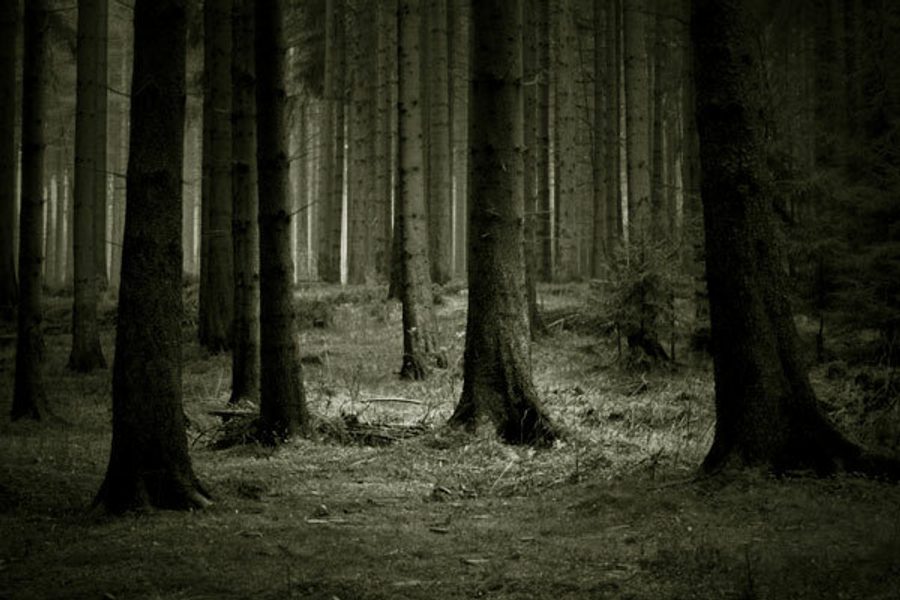The Politics of Enchantment
The quest for a new kinship with nature might just save us.
James William Gibson

Like Special Forces commandos, the L.A. County Sheriff’s deputies and firefighters came at 2 a.m., Jan. 10, 2002, when they knew their enemy would be asleep. After a 71-day siege, the lone warrior knew the end was coming and chained himself into place for one last stand.
Mesmerized, the public watched the arrest of a tree-sitter, who was charged with trespassing. For just over two months, 42-year-old John Quigley, a well-known local environmentalist, had lived amid the boughs of a 400-year-old oak tree, trying to save it from a developer’s bulldozer.
The oak stood at the entrance to a new subdivision of several hundred homes in the Santa Clarita Valley, north of Los Angeles. The Los Angeles County Board of Supervisors had ruled that the tree had to go because it blocked the planned expansion of a two-lane road into a four-lane thoroughfare.
The media loved the story. Parents brought their children to bear witness. Native American groups drummed and danced in solidarity. As posters, poems and tributes collected at its base, the oak started to resemble a monument or memorial.
To millions living in the suburban sprawl of Southern California, the grand old oak had become far more than a tree – it had become a symbol of all the other trees, animal life and open spaces lost to development.
Desires for place and the animal Other
Through the 1990s and early 2000s, a new and striking kind of yearning was evident in the ways ordinary people felt and talked about nature. People were touched by stories of bears who befriended humans, enthralled by the fluid grace of whales, moved to the depths of their souls by majestic trees, newly alive to the sense of mystery, of a world larger than themselves. Some suburban residents came to feel deeply connected to the few remaining open spaces – slivers of forest, wetland, meadow – around them, dedicating years to trying to save them from development. Others restored degraded places such as polluted wetlands and rivers. People began speaking up for the dignity of ordinary domestic animals such as cows and pigs.
How are we to understand this upsurge of feeling? To some degree, it can be considered a product of contemporary environmentalism. But the spreading influence of the environmental movement only partially explains the last two decades’ fundamental change of consciousness. No political movement or platform can account for the intensity of feeling expressed by those who long to rediscover and embrace nature’s mystery and grandeur, who experience an attachment to animals and places so overwhelming that they feel morally compelled to protect them, and who look to nature for psychic regeneration and renewal. More than an ideology, this quest for connection indicates a fundamental rejection of the most basic premises of modern thought and society.
Those premises center on a view of nature as inert matter, void of spirit and consciousness. For an early scientist like René Descartes, writing in the first half of the 17TH century, animals were simply unfeeling machines, incapable of emotions or pain. As the accomplishments of science earned it increasing prestige, this utilitarian view of nature became the dominant mode, further reinforced by the success of industrial capitalism. As Karl Marx and Friedrich Engels observed in The Communist Manifesto, the modern world was built largely through “the subjection of Nature’s forces to man.”
This subjection was so complete it eclipsed humankind’s past and, with it, the traditional unity between humans and the rest of creation that is typical of premodern societies. Among Native American tribes, for example, animal species were, like other tribes, deemed “nations,” such as the buffalo nation or beaver nation.
The premodern cosmos possessed a kind of enchantment. Humans were never alone: The crane flying overhead, the ground beneath one’s feet, the great oak tree near the creek, the creek itself, could all be addressed as kin by those who knew the right words and rituals.
Modernity, as has been widely noted, drained the cosmos of that magic. In Max Weber’s formulation, the West’s elevation of “rational empirical knowledge” led to the “disenchantment of the world and its transformation into a causal mechanism.” Radical and utter isolation followed. Carl Jung, a contemporary of Weber, grasped that loneliness had tragic implications: “Man feels himself isolated in the cosmos. He is no longer involved in nature and has lost his emotional participation in natural events, which hitherto had symbolic meaning for him.”
Yet, the idea of the human world as separate from the rest of nature never gained complete acceptance. A few mavericks and romantics have always seen such isolation as wrong in substance and unbearable in spirit. Over generations, they repeatedly fought back, launching waves of protest, both cultural and political.
A rapidly dying world
The current wave of spiritual interest in nature is not simply another outburst of romanticism. For one thing, it is fueled by a new sense of urgency.
In 2005, the United Nations released the Millennium Ecosystem Assessment, the result of a five-year study of the world’s environment involving some 1,360 scientists. In its executive summary, “Living Beyond Our Means: Natural Assets and Human Well-Being,” the report’s authors write, “Human activity is putting such strain on the natural functions of Earth that the ability of the planet’s ecosystems to sustain future generations can no longer be taken for granted. “
Global warming looms ominously, with the climate changing faster than anything seen since the end of the last ice age some 10,ooo years ago. The rapid rise in temperature is endangering countless animals. People converted more forests and prairies to cropland from 1950 to 1980 than in the century and a half between 1700 and 1850. The destruction of habitat leaves animals with nowhere to go. The report’s authors conclude: “Some 12 percent of birds, 25 percent of mammals, and at least 32 percent of amphibians are threatened with extinction over the next century.”
The assessment reads like a funeral oratory.
A new covenant takes shape
Funerary rhetoric marks what is irretrievably gone, but it also reveals a people’s fundamental moral values – what the deceased meant to those still living, and what their hopes are for the future. In a growing public acknowledgment of kinship, laments for the deceased are now given on behalf of wild animals and places of all kinds. Such oratory serves as a reveille, a call to make amends for creatures’ wrongful deaths by acting to save those who are still left: Outlaw lead bullets, so the few remaining California condors won’t die from lead poisoning when they eat carcasses left by hunters. Urgently study the mysterious deaths of whales. Put the U.S. Navy’s testing of powerful sonar systems under stringent government regulation.
Increasingly, for every funeral story or call for action there is also a tale of resurrection and renewal. Searches for “ghost” species, for instance, are holy pilgrimages, mythic quests to bring back life from death’s grasp. If one near-extinct creature can be restored to a healthy population, then possibly others can, too.
When researchers announced in 2005 that they had videotaped an ivory-billed woodpecker in a forested Arkansas swamp, the first sighting since 1944, government agencies and the Nature Conservancy bought more forested river-bottom lands near the location of the sighting to increase the bird’s chances for survival.
The response to the sighting shows a new covenant between society and nature taking shape. As novelist and bird-watcher Jonathan Rosen commented, the return of the ivorybill offers hope: “It somehow suggests that we have found more than just a missing bird and that God, whom we invoked when we conquered the wilderness, is also present in our effort to get it back.”
Time for a strategic offensive
The current change in environmental thinking is much broader, deeper, and more varied than what has come before. Virtually every part of contemporary culture, from the highest realms of science to the mundane world of commercial television programming, has experienced its revolutionary influence. Already, mainstream geneticists openly discuss the idea of human-animal kinship.
The ultimate goal of this sweeping change, which I call “the culture of enchantment,” is nothing less than the reinvestment of nature with spirit. Flatly rejecting modernity’s reduction of animals, plants, places, and natural forces to either matter or utilitarian resource, the culture of enchantment attempts to make nature sacred once again.
People respond to the culture of enchantment because it offers them something they need (and cannot find elsewhere in consumerist America): transcendence – a sense of mystery and meaning, glimpses of a numinous world beyond our own. The spiritual connections made to animals and landscapes almost invariably lead to a new relationship to nature in general. And nature perceived as “sacred” is allowed to exist on its own terms, for its own sake, valuable simply because it is there.
For nature to retain its mystery, it must retain its autonomy: While its products may be used by people, it is not to be exploited or perceived as a mere resource for human consumption. The culture of enchantment, then, alters the fundamental meanings that the West has given the natural world and imagines a new covenant between people, land and creatures.
The implications of this shift are enormous. If 400-year-old oak trees in Los Angeles can be reenchanted, whole forests or entire mountain ranges or coastlines might come to command our love and respect. Even degraded and polluted landscapes – the kind often found in and around cities – might gain our compassion and be deemed worthy of care. In creating spiritual and moral reasons for reconceiving man’s relation to nature, the culture of enchantment challenges modern institutions, raising standards that few, if any, can now meet.
The momentum behind this cultural transformation suggests that anyone who cares about the Earth should take heart. It has opened people’s imaginations, and in doing so changed the political climate.
The environmental movement and its allies can now shift their strategy from defense to offense. Such an offensive strategy will require a proactive agenda for environmental reform, one in which unambiguous legal mandates against drilling in ANWR and constructing roads in national forests are only the beginning.
The struggle for enchantment is a crucial part of the larger struggle over the kind of culture and society humanity will have.
The reenchantment of nature – if coupled with political courage to act – offers a chance to remake the world.
This essay was adapted from A Reenchanted World: The Quest For A New Kinship With Nature by James William Gibson. Copyright © 2009 James William Gibson. Reprinted by arrangement with Metropolitan Books, an imprint of Henry Holt and Company LLC.
James William Gibson, a sociologist at California State University, Long Beach, also wrote Warrior Dreams: Paramilitary Culture in Post-Vietnam America (1994) and The Perfect War: Technowar in Vietnam (1986).





